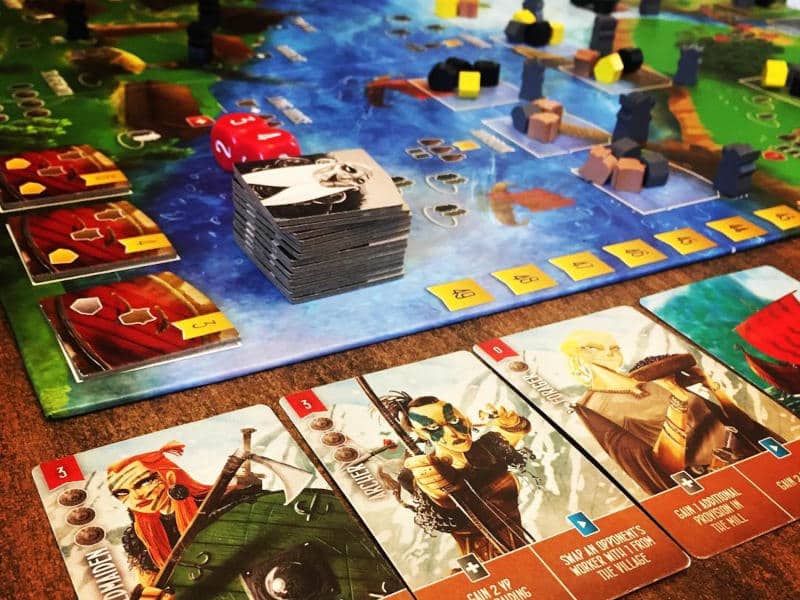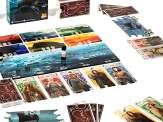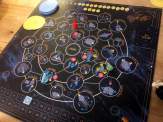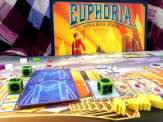| Release Date: 2015 | Players: 2-4 |
| Designer: Shem Phillips | Length: 60-75 minutes |
| Artist: Mihajlo Dimitrievski | Age: 10+ |
| Publisher: Renegade Game Studios | Complexity: 2.5 / 5 |
| Plastic (by weight): n/a | Air (by volume): n/a |
We were a band of feared Viking warriors of Borg on the Lofoten islands. Our chieftain had tasked us with assembling a cunning and mighty crew, collecting provisions and journeying north to plunder gold, iron and livestock from foreign lands. We would find glory in battle and the Valkyrie would lead the fallen to Odin’s Valhalla. We were the Raiders of the North Sea by Shem Phillips from Renegade Games Studios.
Now, I don’t know much about Viking history, other than the stereotypical idea that these were people who used their expert sailing skills to explore new lands and plunder them for precious resources, burning and killing as they went. However, just looking at a map I can see that the Vikings were most likely heading west on their voyages, not north, as the rulebook says. However, some of them were indeed travelling across the North Sea. So the title of the game is absolutely fitting.
As the game’s title suggests, Raiders of the North Sea solely focuses on sending out longships to foreign lands, attacking and pillaging, bringing back riches and honouring the dead who lost their lives along the way. All players live in the same Viking village and want to be the one who impresses the chieftain the most. It’s a game of one-upmanship really. You earn your chieftain’s respect in a number of different ways: attacking and raising foreign settlements to the ground, as well as offering your battle spoils to the chieftain who will reward you accordingly.
Viking Workers
Ultimately, Raiders of the North Sea is a worker placement game, with a bit of resource management and deck building thrown in. There is a bit of a twist though. Nobody owns any workers, even though everyone starts with one. On your turn, you place a worker on one of the available action slots in the village, then take back a different worker. You carry out both actions in that order, which leads to an interesting puzzle.
Sometimes you really need to activate two specific locations, but neither has a worker on it. That means you can only use one of the two worker spaces. Not only that, if you keep an eye on what everyone else is doing, you can create situations where the next player won’t be able to do what you think they were planning to do. It’s a twist on worker placement I hadn’t seen before.
There is another twist though. Workers come in three levels: basic, medium and skilled. Depending on which one is placed in an action space, the action will potentially be more powerful. Some actions are also only available to medium or skilled workers. Now, everyone starts with a basic worker. After a raid, you could return with a medium or even skilled worker. When you place your medium or skilled worker in the village, there may only be basic workers left for you to take. The next player can then take the medium or skilled worker you placed. After all, all of you live in the same village. It’s a simple, but really clever mechanism.

Raiding the North Sea
Your ultimate goal is to raid harbours, outposts, monasteries and fortresses and bring back rich spoils, while also collecting glory along the way. To do so, you need to hire a crew, have enough provisions to last the voyage and sometimes also bring gold along the way.
Your crew comes from a shared deck of townsfolk cards. Each townsfolk has different abilities, effects and battle strength and costs a different amount. Sometimes you want to employ townsfolk in the village to give you one-off effects, but most of the time you want to add them to your crew, where they not only add to the battle strength, but also provide additional effects. For example, some crew give you extra glory when you successfully raid certain locations. Others force your opponents to discard a card from their crew, if they die in battle. It creates another level of interest.
You can collect your provisions from certain locations in the village. The same is true for the money that you need to pay for your crew.
The spoil you bring back from your raids can then be used as offerings for the chieftain. However, you can’t just offer anything you like. There are three tiles available at any one point that show the combination of spoils you need and how much glory you will get in return. As soon as a player has completed one of these tiles, they get the points and the tile is discarded, being immediately replaced with a new one. So you have to be quick or you’ll miss out on points.
Quick and Dirty
Raiders of the North Sea can seem a bit overwhelming at first, but it is really quite easy. Setup in the physical game can be a pain, but I’ve only ever played it digitally. So I never had to worry about placing all the loot onto the board and seeding everything. I just had to click “play” and off I went.
Once you’ve taken a few turns, it’ll quickly all make sense and you can learn additional things as you go. In fact, I think the game does lead players along the way. There is not a lot you can do at the beginning of the game. You will try to collect provisions, earn money to buy crew and keep an eye on what places you can raid and how many points you’re likely to get. On your turn, you will be further limited in your choices based on what action spaces are free. So it’s not really overwhelming to play and it slowly ramps up from round to round. It’s almost like an engine-building game, but not really.
Raiders of the North Sea is really quite addictive. Every game does tend to feel very much the same, but you still want to give it another go. Maybe next time you can outwit your opponents and get the better loot. It’s quite weird. You feel like you have a lot of agency in the game and there is a fair bit of player interaction in the way that you all share workers. At the same time, there is also a lot of luck in what cards you draw and how the loot is distributed on the board. It’s a good balance though.
Happy Raiders
So, at the end of the day, Raiders of the North Sea is the sort of game I happily play any time. In fact, it’s on my wishlist of games to buy in physical form. I love playing against the AI in the digital version, but playing against real people face-to-face is certainly a lot more fun.
If you enjoyed this article, please have a look at my support page to see how you can help keep the blog going.
Useful Links
- Raiders of the North Sea: https://renegadegamestudios.
com/ raiders-of-the-north-sea/ - Rulebook: https://drive.
google. com/ file/ d/ 1LwZ0ve3I6el9dRCIfPeKvFzmtfArqD4S/ view? usp= sharing - Renegade Games Studios: https://renegadegamestudios.
com/ - BGG listing: https://boardgamegeek.
com/ boardgame/ 170042/ raiders-north-sea
Videos
Transparency Facts
I feel that this review reflects my own, independent and honest opinion, but the facts below allow you to decide whether you think that I was influenced in any way. Please also read my Ethics Statement for more information.- I bought and paid for the game myself.
- At the time of writing, I have not received financial support from the publisher or anyone working on their behalf.
Audio Version
Intro Music: Bomber (Sting) by Riot (https://www.
The following music was used for this media project:
Music: Frost by Alexander Nakarada
Free download: https://filmmusic.io/song/10542-frost
License (CC BY 4.0): https://filmmusic.io/standard-license
The following music was used for this media project:
Music: Stöðvar by Alexander Nakarada
Free download: https://filmmusic.io/song/4753-stodvar
License (CC BY 4.0): https://filmmusic.io/standard-license






